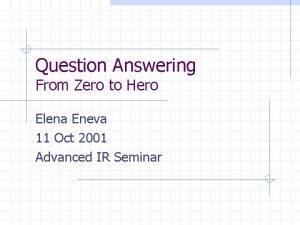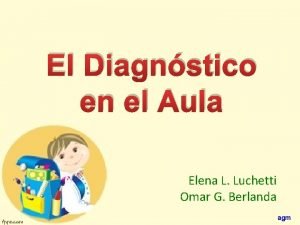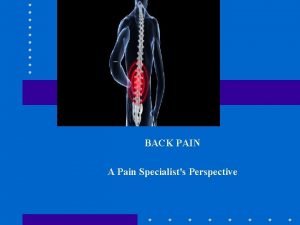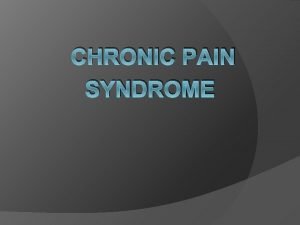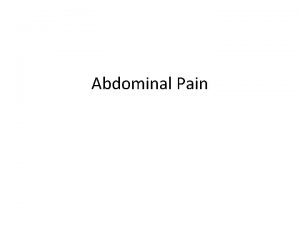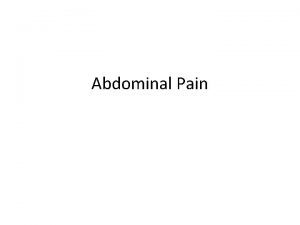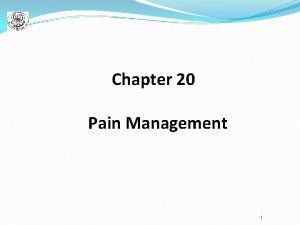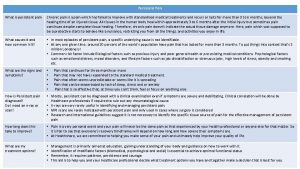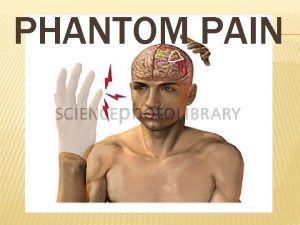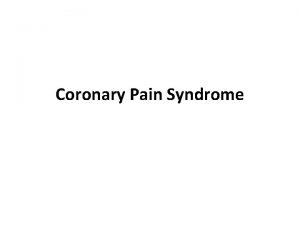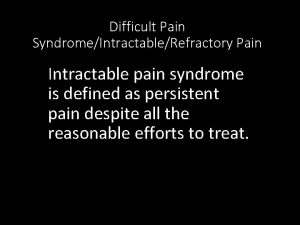10 th Washington Group Meeting PAIN Elena De



























- Slides: 27

10 th Washington Group Meeting PAIN Elena De Palma on behalf of the Italian group Italian National Statistical Institute (Istat) Luxembourg, 3 -5 November 2010

Pain n In the framework of the domains selected to measure health state/disability, pain is very relevant because it could hamper the ability to carry out the daily activities and therefore it could be a cause of restriction in participation. n However, Pain is a difficult symptom to measure. It cannot be measured directly, but must be judged by the individual’s response, which is subjective and influenced by a number of personal and cultural factors. Anyway it is the subjective experience of pain that determines the consequences for the person and the impact on social participation. n Pain is a multidimensional concept but it is important to note that the focus in the ICF as well as in the question set tested is on physical or bodily pain, rather than psychological or emotional pain. n To accurately assess presence of pain and its characteristics a number of dimensions have been identified as important: Frequency, Duration, Intensity, Impact on life (and use of medicine).

Cognitive tests n UNESCAP (2009): Cambodia, Kazakhstan, Maldives, Mongolia, the Philippines and Sri Lanka 1. A total of 143 interviews n GRANADA GROUP (2010): France, Germany, Italy, Portugal, Spain, Switzerland, USA (En) and USA (Sp) • A total of 100 interviews: 89 answered at least to one Pain question, and 65 have completed the domain (13 answered only to Pain 1 and 2 because of no pain). Samples are purposive and try to reflect different health conditions, ages, genders, levels of education and socio-economic statuses. The testing protocols were written in English; countries conducting interviews in other languages were responsible for producing a translated protocol.

Field test n UNESCAP (2009): Cambodia, Kazakhstan, Maldives, Mongolia, the Philippines and Sri Lanka • Each country conducted approx. 1, 000 standardized interviews • • (face-to-face), drawn from a random sample 6, 309 interviews available for the evaluation of the pain question set In addition to the disability questions that were cognitively tested, the questionnaire that was fielded contained specific probe questions designed to provide additional information on those questions where the cognitive interviews indicated that there was some residual interpretation problem.

Questions tested / 1 CT UNESCAP FT UNESCAP CT GRANADA QUESTIONS RESPONSE OPTIONS Do you have frequent pain? Yes/ No Identical Do you use medication for pain? Yes/ No Not tested If “No” to both questions, skip to next section In the past 3 months, how often did you have pain? Some days/ Most days/ Every day Further response option added (“Never”) If “No” to Q 1 and “Never” to Q 2, skip to next section Thinking about the last time you had pain, how long did the pain last? Some of the day/ Most of the day/ All of the day Identical Thinking about the last time you had pain, how much pain did you have, a little, a lot, or somewhere in between a little and a lot? A little/ A lot/ Somewhere in between a little and a lot Identical Closer to a little/ Closer to a lot/ Exactly in the middle Identical If “A little” or “A lot”, skip next question Would you say the amount of pain was closer to a little, closer to a lot, or exactly in the middle?

Questions tested / 2 CT UNESCAP QUESTIONS RESPONSE OPTIONS Thinking about the last time you had pain, was the pain worse than usual, better than usual, or about the same as usual? Worse than usual/ Better than usual/ About the same as usual How would you describe your pain? (Free text) How old were you when the pain began? (Age in years) Is your pain due to a health problem of something else? Due to a health problem/ Something else (to be specified: …) Does your pain limit your ability to carry out daily activities? Not at all/ A little/ A lot/ Completely Does your pain limit your ability to carry out other activities that are not part or your day -to-day life? Yes/ No * FT UNESCAP CT GRANADA Not tested Re-worded* Not tested Identical Not tested Re-worded** (How much. . ) Not tested Please tell me which of the following statements, if any, describes your pain: (It is constantly present/ Sometimes I am in a lot of pain and sometimes it is not so bad/ Sometimes it is unbearable and excruciating/ When I get my mind on other things I am not aware of it/ Medication can take my pain away completely/ My pain is because of work/ My pain is because of exercise) ** How much does your pain limit your ability to carry out daily activities?

Main goals of the Granada Group analysis / 1 In the Granada Group test, specific goals were set for the analysis: 1. To compare Pain 1 and the set of questions Pain 2 -3 -4 (frequency/duration/intensity) as possible alternative to measure pain 2. To assess whether the two questions about last episode (Pain 3 -4) were both necessary or the information they gather was redundant/overlapping.

Main goals of the Granada Group analysis / 2 To reach these goals two indexes were calculated: 1. The Continuum Index is a synthesis of all information on pain collected in the domain. • To each answer category for each question was given a weight which was proportional to the: frequency/duration/intensity/impact of pain. It goes from a minimum score of 0 corresponding to absence of pain, to a maximum of 14, corresponding to the highest level of pain. n Index 3 is an indicator that combines information from the set of questions Pain 2 -3 -4. • The indicator ranges from 0 (no pain) to 6 (highest level).

Findings on Pain n From both cognitive tests: n Type of pain: mainly physical pain. 1. Long-term injuries, injuries without specification of duration, disease-related pain, disability-related pain, muscular pain and soreness, acute or chronic pain. n Sites of pain experienced: different parts of the body such as head, neck, eyes, teeth, back, arms, knees, feet, etc. n Cause of pain: in some cases it was specified as an accident (war, sport, car), disability, stress/overwork, disease, weather changes

Do you have frequent pain? / 1 n The adjective “frequent” was included in the wording of Pain 1 to try to avoid capturing the occasional experience of pain that lasts only for a short period and it is easily resolved by medication, and thus to capture the pain experienced above a relatively low or common threshold. n The adjective “chronic” was considered and seen to be a medical term not universally understood; hence “frequent” was preferred.

Do you have frequent pain? / 2 n Some respondents wondered/asked: 1. What “pain” means 2. How was this different from chronic or constant pain 3. What “frequent” means n Data from both cognitive tests illustrates the variation among respondents in the reporting of pain. n Variation appears to relate to: • Respondents’ interpretation of “frequent” • Respondents’ belief in whether the cause • • is worth to report pain Whether respondents believe their pain is “usual” and whether believe the question is asking about “usual pain” Whether respondents believed their pain was intense enough to report

Do you have frequent pain? / 3 n GRANADA GROUP: To be able to evaluate more accurately whether Pain 1 picks up the general concept… 1. We plotted the answer to Pain 1 on the Continuum 2. We cross-tabulated Pain 1 with Pain 6 (impact of pain)

Have frequent pain Vs. Continuum n The good performance of Pain 1 was pointed out by comparing it to the continuum created with all information collected on pain. The table shows how the average score is higher for who has answered YES to Pain 1 in all country. Mean value of Continuum Index by Pain 1 and by Country, among persons who completed the domain answering to all questions COUNTRY FRANCE GERMANY ITALY PORTUGAL SPAIN SWITZERLAND UNITED STATES (En) UNITED STATES (Sp) ALL NO 3. 1 3. 0 4. 5 1. 0 2. 3 0. 0 2. 8 YES 8. 7 8. 2 8. 0 9. 2 7. 3 10. 3 9. 0 8. 8 TOTAL 4. 9 7. 3 5. 9 5. 0 6. 0 4. 8 7. 4 7. 5 6. 0

Have frequent pain Vs. Impact n Given the hypothesis that Pain 1 had the aim of measuring non -occasional pain and pain that could have an impact on daily life, in order to eliminate inconsistencies, we took into account only the 43 respondents who seemed from the narrative to refer to the same kind of pain in answering to Pain 1 and Pain 6. n By looking at the association between these two questions, we found that: 1. In 4 cases, people answered “No” to Pain 1 and referred 2. limitations (they are individuals who reported episodes of pain but they did not describe them as frequent, or who declared to have pain but not so intense to be reported) In 10 cases, people answered “Yes” to Pain 1 but “a little” limitations to Pain 6 (from the narratives it was possible to identify that some of these cases are due to individuals adapting their activities to their condition or to use of medicine).

Do you use medication for pain? This question has not been tested in the Granada Group as well in the field test because results of CT UNESCAP have showed that it did not work well. n UNESCAP: The use and types of medicines reported vary in ways that do not provide clear evidence of how the data should be interpreted. Some respondents asked what they should count. • Interpretations: Western vs. traditional or alternative medicine; Overthe-counter vs. prescription; Ointments vs. ingested tablets n GRANADA GROUP: The test showed that while some respondents answered taking into account the use of medications, some others did not. • It would be important at least to specify in the questions if respondents should refer to pain considering or not considering medication. This issue goes along all questions.

Frequency, Duration and Intensity n UNESCAP: The cognitive test did not capture as much information as desired about these important dimensions of pain. In several cases, due to time constraints, questions or probe questions were not asked. n Furthermore, it should be noted that in this test those respondents who referred no frequent pain and not to take any medication were filtered out of the domain. n In the test carried out by the GRANADA GROUP, instead, the question “In the last 3 months, how often did you have pain? ” was asked regardless of how respondents answered to the question on frequent pain. • As regards the time reference, 32 out of 80 respondents answered referring to the last 3 months

Duration and Intensity In both cognitive tests it was found that: n Some respondents have difficulty in estimating how long their pain lasts and in some cases the response categories did not correspond well to how some respondents measured the duration of their pain. n Some respondents had not limited their answer to just their last experience of pain. n The response categories “a little/a lot/somewhere in between” seemed easy to most respondents, and respondents appear to have little difficulty also with the follow up question for those who answered “somewhere in between” (UNESCAP CT, FT).

Pain 2 -3 -4 In the Granada Group test, questions Pain 2 -3 -4 were meant to be a possible alternative way to measure pain, comparing to Pain 1. n To evaluate the performance of this set of questions the Index 3 was built. n It was possible to group the results into 3 homogeneous classes: no/very low pain (27. 3) %; medium level of pain (45. 5%); high level of pain (27. 3%). n By looking at the mean score of the continuum for each group of respondents with the same value of Index 3, the results show a good level of association between the two variables.

Pain 2 -3 -4 – Field test Summary Pain Measure n Frequency (last 3 months), Duration (last time) and Intensity (last time) were combined to provide a meaningful, yet succinct, measure of pain. n The test findings demonstrate that all these three dimensions are equally important for describing the phenomenon, each one capturing slightly different aspects of pain. n However, combining data on these Pain measure summarizing frequency, duration and intensity dimensions into a single scale would be PERCENT analytically useful. It was explored the SUMMARY PAIN MEASURE possibility to create a categorical scale LOW 52. 9 in which frequency, duration and MIDDLE 15. 6 intensity are synthesized by a three. HIGH 31. 5 level summary pain measure TOTAL 100. 0 (low, middle, high).

Pain 3 and Pain 4: Last time you had pain… n To assess whether the two questions about last episode (Pain 3 -4) were both necessary or the information they gather was overlapping, the distribution of Index 3 was compared to those of similar indicators based on: 1. Pain 2 (frequency) and Pain 3 (duration) 2. Pain 2 (frequency) and Pain 4 (intensity) n From this analysis a substantial overlapping is observed between the complete Index 3 and the index based only on Pain 2 and Pain 4. n Moreover, some interviewees had problems in answering to Pain 3, because they thought about very short episodes or about intermittent pain which they had difficulties classifying in terms of length of time. n We can conclude that to collect information on pain, if question Pain 4 is used, Pain 3 might be not included.

Pain 1 vs Index 3 PAIN 1 1 2 3 4 5 6 No 7 3 0 1 0 0 11 Yes 4 5 1 9 7 6 32 11 8 2 11 7 6 43 Total Pain due to polyartritis. Intensity and frequency timevariable. He takes medicines. Headache due to don’t wear glasses. Pain due to how he sleeps. degenerative osteoarthritis He feel pain time to time due to efforts. thought about my arms and knee, they often hurts. Hip pain. Total Not permanent pain. He refers to some different kind of pain related to the sports activities. stomach, pyrosis always.

How old were you when the pain began? – Granada Group n When more than one pain were mentioned by respondents, these wondered to which pain the question was referring to n Few interviewees were not able to remember exactly when the pain started n Asking when the pain began does not imply that the pain existed continuously between then and the present, for intermittent conditions.

How much does your pain limit your ability to carry out daily activities? – Granada Group n Some respondents have difficulty in answering to this question. They wondered if they should refer to the last time they had pain or to present. n Moreover, in certain cases the possibility to compare answers might be hampered by how respondents considered the use of medicines, which in some cases had an impact on the response to this question. n Some individuals stated that they decided that pain could not interfere on their daily activities, and others referred that they “adapted” their activities to their experience of pain, and therefore they do not perceive themselves as limited.

Main Conclusions / 1 n It seems that Pain 1, as well as the set of Pain 2 -3 -4 allow to identify the more serious cases of pain. n The limit of Pain 1 is that it doesn’t allow to distinguish the level of severity of pain. n The limit of Pain 2 -3 -4 is that in some cases, referring to the last 3 months, they capture episodic pain (i. e. due to accidents or pregnancy). Comparing Index 3 with Pain 1 no evidence of inconsistency was found inside of the class “high level of pain”. These questions provide a scale of severity avoiding the problems occurred in some cases with the understanding of the term “frequent”. n Moreover, if it were necessary to reduce the number of questions, it would be possible to obtain similar results using only Pain 2 (frequency) and Pain 4 (intensity).

Main Conclusions / 2 n How much does your pain limit your ability to carry out daily activities? This question covers another important dimension of pain. People who suffer from chronic pain is often able to manage it to reduce its actual impact on functioning and participation, as tests have showed. It should be kept in a set of questions on pain. However, two main issues must be addressed: self-limitation of activity and use of medicine by the respondents n Use of medicine is an important accommodation for pain. Indeed this use may come into play in all questions and thus it must be clarified if we want to measure pain with or without considering it.

Continuum QUESTI ONS PAIN 1 PAIN 2 PAIN 3 PAIN 4/ 4 a PAIN 6 RESPONSE OPTIONS No Yes Never Some days Most days Every day Some of the day Most of the day All of the day A little Somewhere Closer to a little Exactly in the middle between a little and a lot/ Missing/ in between a little and a Did not ask Closer to a lot A lot Not at all A little Between a little and a lot A lot Completely Scor es 0 2 0 1 2 3 1 1. 5 2 2. 5 3 0 1 1. 5 2 3

Index 3 was built as a synthesis of Pain 2 -3 -4. Firstly, the responses “somewhere in between” to Pain 4 (intensity) were re-classified according to the response given to Pain 4 a. PAIN 4 (Last time – Intensity) PAIN 3 (Last time – Duration) A little/ Closer to a little All of the day Most of the day Some of the day Then, 4 Types of pain were defined by crossing the responses to Pain 3 (duration) and those to Pain 4 (intensity), as in the table above Eventually, the responses to Pain 2 (frequency in last 3 months) were crossed with the Types of pain so classified, and 6 levels were identified as Index 3 RESP. TO PAIN 2 Never CONTINUOU S HIGH SPORADIC MEDIUM-LOW SPORADIC HIGH INDEX 3 Score Classes 0 1 No/ Low level 3 Medium level of pain 4 Most days/ Every day 5 6 A lot/ Closer to a lot CONTINUOUS MEDIUM-LOW 2 Some days Exactly in the middle High level of pain TYPES OF PAIN Any Sporadic Continuou s Mediumlow High
 Martian pain
Martian pain Can period pains be a sign of pregnancy
Can period pains be a sign of pregnancy Is pregnancy pain same as period pain
Is pregnancy pain same as period pain Today meeting or today's meeting
Today meeting or today's meeting Proposal kickoff meeting agenda
Proposal kickoff meeting agenda What is meeting and types of meeting
What is meeting and types of meeting Types of meeting
Types of meeting Flacc pain scale ages
Flacc pain scale ages Ug ugbo
Ug ugbo Jlab user group meeting
Jlab user group meeting Elena hollander
Elena hollander Elena just
Elena just From zero to hero elena
From zero to hero elena Elena popova school
Elena popova school Montani home inspection
Montani home inspection Elena in arabic
Elena in arabic Elena marchiori
Elena marchiori Elena bohn
Elena bohn Elena nembrini
Elena nembrini Elena folini
Elena folini Elena joshi
Elena joshi International planning process phases
International planning process phases Maria elena maglaris
Maria elena maglaris Elena santiago cid
Elena santiago cid Prepeat printer pronunciation
Prepeat printer pronunciation Elena flerova
Elena flerova L
L Elena brunetto
Elena brunetto












